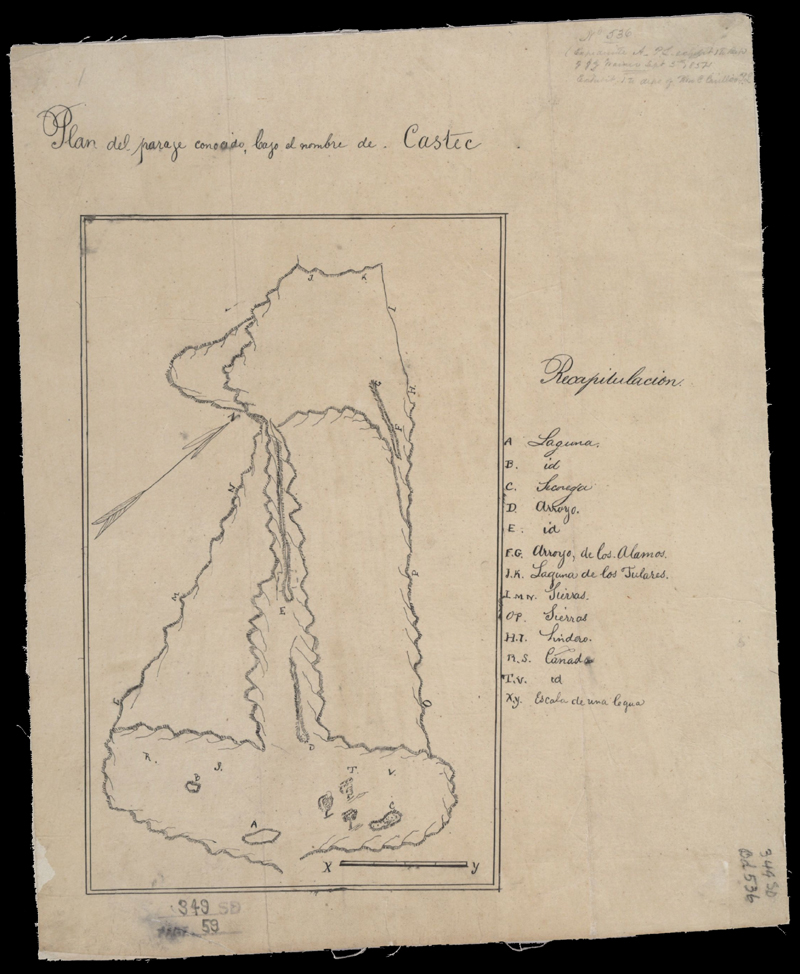|
|
Lebec-Tejon Area

Click image to enlarge "Plan del paraje conocido bajo el nombre de Castec" ("Plan area known under the name of Castec") by Esteban Ardisson. Undated; believed to be approx. 1842. Original in the Bancroft Library at UC Berkeley. There is a date of 1857 at upper right; that date relates not to the map's origin but rather to its entry into evidence in federal court while the landowner was in the process of proving his claim to the property. Just as there are two Castaic Lakes (the natural one east of Lebec and the man-made reservoir that's part of the State Water Project), so were there two Castaics. The one most people know is the newer one. The original one was an 1843 Mexican land grant that stretched roughly from modern-day Lebec north to the bottom (north side) of the Grapevine. Rancho Castec, as it was called (also Castac, Castaic and several other spellings) was eventually absorbed into the Tejon Ranch. Both "Castaics" derive their name from the Chumash word, Kashtiq, meaning "like an eye" (see Johnson 1978) ... and the correct pronunciation, at least of the modern community of Castaic, is cas-STEAK. The 22,178-acre Rancho Castec was granted to a politically connected schoolteacher named José Maria Covarrubias (alternately Covarubias or Covarabias) on Nov. 22, 1843, by Manuel Micheltorena, then-governor of Alta California. Covarrubias had emigrated from France in 1834 and became a naturalized Mexican citizen (only Mexican citizens could own land). He held various government positions in the state capitol of Monterey and in Santa Barbara, where he served as mayor. Along the way he was awarded additional land grants. Covarrubias was a member of the California Constitutional Convention in 1849, and under American rule, he served in the state Assembly from 1849 to 1862. He bought the island of Santa Catalina in 1850. On Aug. 10, 1854, the U.S. Army garrisoned Fort Tejon on a section of the Rancho Castec property, in order to control Native Americans on the 75,000-acre Sebastian (aka Tejon) Indian Reservation — which Edward F. "Ned" Beale, then Superintendent of Indian Affairs for California and Nevada, was setting up 17 miles northeast on the original Rancho El Tejon — and to guard against raiding parties from other tribes. The fort lasted just 10 years, until Sept. 11, 1864, when the Army needed to save money to fight the South. Meanwhile, like other landed citizens, José Covarrubias had to prove his formerly Mexican property ownership under the U.S. Land Act of 1851. He filed on Rancho Castec in 1853 and the U.S. Public Land Commission finally upheld his claim in 1866 — by which time he no longer owned it. Chalk it up to Ned Beale. After Covarrubias filed for the patent, Beale, now Lincoln's Surveyor General for California and Nevada, was instructed to survey the property and set the metes and bounds. In the course of doing so, Beale had his assistant, Samuel A. Bishop, buy the rancho from Covarrubias. It was Beale's modus operandi; Lincoln fired him in 1863 because the president didn't want a surveyor who became "monarch of all he has surveyed" — and also because Beale tended to spend more than Congress allotted, and for "accounting irregularities." In what was probably a paper transaction to avoid scrutiny, Bishop flipped the property to Beale's partner, Robert Symington Baker, who sold it to Beale in 1866. Bishop had moved onto the property in 1864 to manage Beale's holdings on both sides of the Los Angeles-Kern County border, which now included the following: Rancho El Tejon, 97,612 acres (which he purchased from Juan Temple); Rancho Los Alamos, 26,626 acres; Rancho Castec, 22,178 acres; Rancho La Liebre, 48,799 acres; various railroad lands, 54,000 acres; and property purchased from settlers, 20,000 — for a whopping total of 269,215 acres (Thompson 1983:232). In the 1880s, late in life, Beale wanted to sell the property to someone who would develop it into homes and farms for settlers, but he still owned it when he died in 1893. His heirs sold it to the principals of the Los Angeles Times, who took the combined holdings public as the Tejon Ranch Co. (NYSE: TRC). More than a century later, it looks like Beale's dream of a community for settlers is finally starting to come to fruition. — Leon Worden 2013
LW2521: 19200 dpi jpeg from digital file. |
• Johnson: The Trail to Kashtiq
Map ~1842
Beale Map 1862
News Item 11-22-1915
Real Castaic Lake 1919x2
Real Castaic Lake 1920s
Snowman 1922
Legend of Indian Massacre, News Report 1927
Real Castaic Lake 1930s
Real Castac Lake ~1930s
Snowfall 10/1949 x2
Wines Richfield
|
The site owner makes no assertions as to ownership of any original copyrights to digitized images. However, these images are intended for Personal or Research use only. Any other kind of use, including but not limited to commercial or scholarly publication in any medium or format, public exhibition, or use online or in a web site, may be subject to additional restrictions including but not limited to the copyrights held by parties other than the site owner. USERS ARE SOLELY RESPONSIBLE for determining the existence of such rights and for obtaining any permissions and/or paying associated fees necessary for the proposed use.










